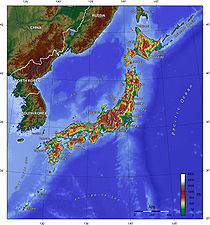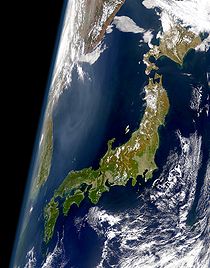
Japanese Archipelago
Encyclopedia


Country
A country is a region legally identified as a distinct entity in political geography. A country may be an independent sovereign state or one that is occupied by another state, as a non-sovereign or formerly sovereign political division, or a geographic region associated with a previously...
of Japan
Japan
Japan is an island nation in East Asia. Located in the Pacific Ocean, it lies to the east of the Sea of Japan, China, North Korea, South Korea and Russia, stretching from the Sea of Okhotsk in the north to the East China Sea and Taiwan in the south...
, extends roughly from northeast to southwest along the northeastern coast of the Eurasia
Eurasia
Eurasia is a continent or supercontinent comprising the traditional continents of Europe and Asia ; covering about 52,990,000 km2 or about 10.6% of the Earth's surface located primarily in the eastern and northern hemispheres...
mainland, washing upon the northwestern shores of the Pacific Ocean
Pacific Ocean
The Pacific Ocean is the largest of the Earth's oceanic divisions. It extends from the Arctic in the north to the Southern Ocean in the south, bounded by Asia and Australia in the west, and the Americas in the east.At 165.2 million square kilometres in area, this largest division of the World...
. It is composed of islands from the Sakhalin island arc
Sakhalin island arc
Sakhalin island arc is an ancient volcanic arc dating from the Early Miocene. The arc was a result of the Okhotsk Plate subducting beneath the Eurasian plate in the convergence zone. The arc runs from mainland Asia through Sakhalin Island into central Hokkaido and the collision zone around the...
and the Northeastern Japan arc
Northeastern Japan Arc
Northeastern Japan Arc also Northeastern Honshū Arc, is an island arc on the Pacific Ring of Fire. The arc runs north to south along the Tohoku region of Honshū, Japan. It is the result of the subduction of the Pacific Plate underneath the North American Plate at the Japan Trench...
.
The term Home Islands was used at the end of World War II
World War II
World War II, or the Second World War , was a global conflict lasting from 1939 to 1945, involving most of the world's nations—including all of the great powers—eventually forming two opposing military alliances: the Allies and the Axis...
to define the area of Japan to which its sovereignty and the constitutional rule of the Emperor
Emperor of Japan
The Emperor of Japan is, according to the 1947 Constitution of Japan, "the symbol of the state and of the unity of the people." He is a ceremonial figurehead under a form of constitutional monarchy and is head of the Japanese Imperial Family with functions as head of state. He is also the highest...
would be restricted. The term is also commonly used today to distinguish the archipelago from Japan's colonies and other territories in the first half of the 20th century, but is not used in reference to the country as it exists today.
Island components
The archipelago consists of 6,852 islands ("island" defined as land more than 100 m in circumference), of which 430 are inhabited. The four main islands, listed in descending order from north to south, are:- Hokkaidō Island
- Honshū Island
- Shikoku Island
- Kyūshū Island
Palaeogeography
Changes to the Japanese archipelago over time:
External links
37.514444°N 137.712222°Wcenter of mass

